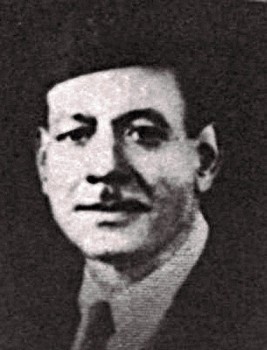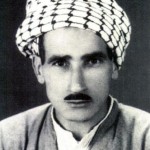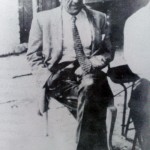 The Arab Music Archiving and Research foundation (AMAR), in collaboration with the Sharjah Art Foundation (SAF), presents “Min al-Tārīkh”.
The Arab Music Archiving and Research foundation (AMAR), in collaboration with the Sharjah Art Foundation (SAF), presents “Min al-Tārīkh”.
Dear listeners,
Welcome to a new episode of “Min al-Tārīkh”.
Today, we will be resuming our discussion about the disciples of al-ṭarīqa al-Qundargiyya, i.e. Rashīd al-Qundargī’s ṭarīqa, with our guest Mr. Husayn al-A‘zami.
Tell us about other disciples of al-ṭarīqa al-Qundargiyya, Mr. Husayn.
Rashīd al-Faḍlī (1904 – 1969) is another maqām muṭrib among the disciples of al-ṭarīqa al-Qundargiyya. I have given him quite a strange description derived from the way I imagine him when I listen to him. And I did listen to him a lot as some of his maqām-s were broadcasted by the Radio.
Even though I categorized Rashīd al-Faḍlī among the disciples of al-ṭarīqa al-Qundargiyya in my book, listening to his maqām-s and delving into his performance style do not automatically or unquestionably categorize him as such. Neither do they categorize him within any other singing style or ṭarīqa existing during his artistic birth, including al-ṭarīqa al-Zaydāniyya among others. And we can’t state either that Rashīd al-Faḍlī had his own ṭarīqa in singing maqām-s as those he recorded at the Baghdad Radio are an unorganised blend of various styles that influenced him during his artistic birth. This is the honest and direct statement I made in my book on Rashīd al-Faḍlī. He was unable to organise his singing or to set a clear method, as it seems that the evolution during the Period of Change he witnessed was too fast for him to be able to fully grasp anything. So he sang maqām-s under this form whose style is not well-defined, yet whose characteristics may categorise him within al-ṭarīqa al-Qundargiyya. These characteristics include notably his interest in and respect for the maqām form, added to his interest in the maqām melodic patterns more than his interest in clarifying the terms defining al-ṭarīqa al-Qundargiyya. Including him in this book on al-ṭarīqa al-Qundargiyya is more logical and better than categorising him within any other style, and thus he became a disciple of al-ṭarīqa al-Qundargiyya…
(♩)
Now concerning the voice of Rashīd al-Faḍlī… Muṭrib Rashīd al-Faḍlī is considered to be among the good maqām muṭrib-s who were born and whose artistic journey started during the Period of Change that I have determined in my book as the first third of the 20th century, and he lived until the Trial Period that is the second third of the 20th century, i.e. from the mid-1930s to the mid-1960s. I called the last third of the 20th century the Period of Maturity. His performance skills come close, at best, to those of his contemporaries who were good singers, but he never reached the level of muṭrib Najm al-Shaykhalī in maqām performance for example, while he invested a lot of work in singing Iraqi maqām and must be considered among the good maqām singers who witnessed a period during which many changes and developments affected all fields of life. Rashīd al-Faḍlī exploited in a distinctive manner this environmental past and present as a subject for his maqām singing, and his imprecise style bears sad expressions, mostly dominated by distress and misery…
(♩)
Aḥmad Mūsa (1905 – 25/8/1968) whose name is still repeated in the maqām milieus despite the decline of his fame after he passed away in 1968, started off his artistic journey during the same period that witnessed the artistic start of many maqām singers who gave concerts at the Radio that were broadcasted live after the Radio was established –we mentioned previously that these weekly Iraqi maqām concerts were never recorded and are lost forever. So, he is among those who gave these Radio concerts that were broadcasted live and most of which were never recorded or documented since the launch of the Radio. They went unrecorded until the mid-1950s or the early 1950s. In the following years, and until he passed away, he recorded numerous maqām-s at the Radio’s studios. The most important of these maqām-s that the audience heard are the maqām ‘araybūn ‘ajam and the maqām ‘araybūn ‘arab together in one maqām, the maqām ibrāhīmī, and the maqām ḥusaynī. His singing performance of these maqām-s is characterised by its authentic Baghdadi expressions and his precise compliance with the principles of the ṭarīqa Qundargiyya whose expressions he enjoyed, as made obvious by his recordings, exploiting these values in order to express with a beautiful and refined sadness characterized by truthfulness, displaying his quality as an artist whose expressions were derived from his experience.
He sang poet Ibn Malīk al-Ḥamawī’s qaṣīda to the beautiful maqām ḥusaynī…
Qaṣaman bi-ḥifẓi ‘uhūdikum wa-widādī lam aqḍī minkum fī al-gharām murādī
Wa-‘alaykum ḥasd al-‘adhūli a-mā kafa ḥatta al-‘awādhilu fī al-hawa ḥussādī
Wa-li-shaqwatī fī al-ḥubbi qad ‘azz al-ruqā lammā tanā’aytum wa-‘azza ruqādī
Mā dhāka illā anna amyāl al-jafā ṭālat wa-ṭarfī kuḥḥilat bi-suhādī
Fa-murū jufūnī bi-al-kara li-tarākumu wa-tabītu min waṣlin ‘ala mī‘ādī…
(♩)
Dear listeners,
We have reached the end of today’s episode of “Min al-Tārīkh”.
We have listened today to Mr. Rashīd al-Faḍlī performing both the maqām madmī and the maqām mukhālaf and to Aḥmad Mūsa performing the maqām ḥusaynī.
We will meet again in a new episode to resume our discussion about the disciples of al-ṭarīqa al-Qundargiyya.
We thank Mr. Husayn al-A‘zami.
“Min al-Tārīkh” is brought to you by Mustafa Said.
- 221 – Zakariyya Ahmed – 12 (1/9/2022)
- 220 – Zakariyya Ahmed – 11 (1/9/2022)
- 219 – Zakariyya Ahmed – 10 (11/25/2021)
- 218 – Zakariyya Ahmed – 9 (10/26/2021)
- 217 – Zakariyya Ahmed – 8 (9/24/2021)
- 216 – Zakariyya Ahmed – 7 (9/4/2021)
- 215 – Zakariyya Ahmed – 6 (8/28/2021)
- 214 – Zakariyya Ahmed – 5 (8/6/2021)
- 213 – Zakariyya Ahmed – 4 (6/26/2021)
- 212 – Zakariyya Ahmed – 3 (5/27/2021)
- 211 – Zakariyya Ahmed – 2 (5/1/2021)
- 210 – Zakariyya Ahmed – 1 (4/28/2021)
- 209 – W-al-Lāhi lā astaṭī‘u ṣaddak 2 (4/6/2017)
- 208 – W-al-Lāhi lā astaṭī‘u ṣaddak 1 (3/30/2017)
- 207 – Bashraf qarah baṭāq 7 (3/23/2017)


